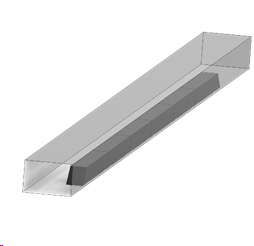Mechanism of aerodynamic force generation concerning train vibration in tunnel
(LES of large-scale flow structure around simplified train model)
 |
 |
 |
| Koji NAKADE Railway Technical Research Institute |
Yutaka SAKUMA Railway Technical Research Institute, currently Tokushima Bunri University |
Takeo KAJISHIMA Osaka University, currently Shikoku Polytechnic College |
Abstract
To clarify the mechanisms underlying airflow-induced vibrations of high-speed trains running through tunnels, large-eddy simulation of a large-scale flow structure around a simplified 6-car train model was conducted (Fig.1). Since actual trains run on one of the double track lines, the position of the train model was made to deviate from the tunnel center and hence the gap between one of the sides of the train and the tunnel wall is narrower than that of the other side. A train running in the open air was also calculated for comparison. The results of this study shed light on the generation mechanism of the pressure fluctuations acting on the side of high-speed trains as follows. Firstly, in the open air, the air velocity relative to the train in the space between the underbody and the ground gradually decreases from the head toward the tail of the train. Thus, the air velocity relative to the train is lower than that on both sides of the train, which generates shear flows near the bottom edges of both sides of the train. The shear flows cause large Karman vortex-like vortices (staggered Karman vortex street), which in turn lead to a meandering airflow beneath the underbody of the train. Secondly, in the tunnel, the air velocity relative to the train not only in the gap between the underbody and the ground but also in the narrower gap between the side of the train and the tunnel wall gradually decreases from the head toward the tail of the train. In the same mechanism as the open air, a meandering airflow is generated throughout the side and underbody of the train and causes pressure fluctuations along the side of the train (Fig.2). Finally, it is demonstrated that the wavelength of pressure fluctuations along the side of the actual train can be estimated from the present LES results.
Keywords
Train aerodynamics, Flow-induced vibration, Train in tunnel, Meandering airflow, Large-eddy simulation
Figures

Fig. 1 Simplified 6-car train and tunnel model (Train in tunnel).

Fig. 2 Instantaneous velocity fluctuation distribution on the horizontal plane under the train and on the vertical plane on the side of the train (from 5th to 6th car) running in tunnel section. A large-scale flow structure is formed in underbody flow and in side body flow.

